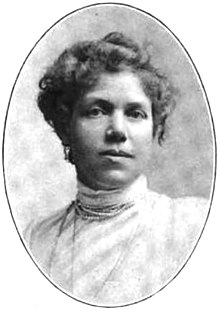Cora Slocomb di Brazza | |
|---|---|
 Slocomb di Brazza in Rome, 1904 | |
| Born | Cora Ann Slocomb January 7, 1862 New Orleans, Louisiana, US |
| Died | August 24, 1944 (aged 82) Rome, Italy |
| Other names |
|
| Citizenship |
|
| Occupations |
|
| Years active | 1887–1906 |
| Children | 1 |
| Mother | Abby Day Slocomb |
| Relatives | Idanna Pucci (great-granddaughter) |
| Signature | |
Cora Slocomb di Brazza (January 7, 1862 – August 24, 1944) was an American heiress and Italian activist, businesswoman, and philanthropist. Born into a wealthy family in New Orleans, she relocated to Connecticut after her father's death and was raised in Quaker traditions. Privately tutored, she studied in France, Germany and the Isle of Wight, taking painting lessons with Frank Duveneck. In 1887, she went to Italy and married Detalmo Savorgnan di Brazza, brother of explorer Pierre Savorgnan de Brazza. They settled in his family estate at the Castello di Brazzà in Moruzzo in the Province of Udine, wintering in Rome. She created a lace-making school and eventually opened seven Brazza Lace Cooperative Schools. Besides promoting basic education, the schools taught bobbin lace-making and marketed the wares to help women rise above poverty. Speaking four languages, Slocomb di Brazza printed various language pamphlets to attract interest from abroad in their products. She displayed the goods of the Lace Cooperative Schools at trade shows and world fairs. She also was successful in a drive to reduce US import duties on handcrafted items in 1897, arguing that the tariffs would drive up immigration.
Involved in the peace movement from 1889, Slocomb di Brazza created the peace flag and was the founder of the International Council of Women's Committee on Social Peace and International Arbitration in 1897. The committee worked to create agreements for nations to solve conflicts diplomatically and avoid war. Aligned with her peace work, she undertook numerous humanitarian drives to assist immigrant communities, reduce strife caused by cultural differences, and improve Italian–American relations. Slocomb di Brazza campaigned against the death penalty, fighting for a pardon and then assisting accused murderer, Maria Barbella, in gaining a second trial, at which she was acquitted. She attended the 1903 and 1904 Congresses of the International Council of Women, representing the Consiglio Nazionale delle Donne Italiane (CNDI, National Council of Italian Women). With activists from CNDI, she founded the Società Cooperativa delle Industrie Femminili Italiane (IFI, Italian Women's Industries Cooperative Society) in 1903 to remove middlemen who exploited craftswomen. In 1906, Slocomb di Brazza developed a mental illness which kept her isolated and confined for the next thirty-seven years. The Brazza Cooperative Lace Schools which she initiated are still operational and the peace flag she designed has been widely used in international ceremonies and celebrations.